Useful Information
1. Proposal and experiment application
Before submitting the proposal, please read the introduction of the endstation and the research content carefully, or contact the beamline staff to confirm that the proposal is suitable for conducting at this endstation. Please register and submit your application on the Sharing Service Platform of CAS Large Research Infrastructures of Chinese Academy of Sciences. After the proposal is approved and the beamtime is allocated, submit the experimental application on the same platform. The experimental time must not exceed the total beamtime.
2. Operation Schedule and Status
Users can check the operation schedule and the current operating status which can be accessed on the website (http://www.nsrl.ustc.edu.cn/main.htm), and apply for the experimental time reasonably in combination with their own experimental progress.
3. Preparations before the experiment
After the users confirm the experimental time, they can contact the staff in the user's office (yhb@ustc.edu.cn, 0551-63602018) about the matters such as radiation safety training, radiation dose plates, user passes and accommodation.
Before confirming the experimental arrangement, it is recommended that users communicate with the beamline staff to discuss the feasibility of the experiment, the preparatory work and the experimental operation process, etc.
For the experiments of photoelectron spectroscopy and near-edge X-ray absorption fine structure spectroscopy, the users need to confirm the following information with the beamline researchers:
1. The samples are stable with no decomposition and volatility.
2. The samples are non-radioactive, non-highly toxic and non-strongly magnetic.
3. The samples should be fully dried.
4. The powder samples should be as fine as possible.
5. The surface of thin sheet block samples should be smooth.
6. During the preservation and transfer of samples, the surface of the samples should be kept from being contaminated as much as possible. Do not touch the surface of the samples with your hands.
7. Try to prepare fresh samples for testing.
4. Research contents of Catalysis and Surface Science Endstation
The research contents of the Catalysis and Surface Science Endstation include the analysis of material electronic structure, the study of catalytic reaction mechanism, the analysis of surface and interface electronic structure, and the study of interface properties of optoelectronic devices, etc. The endstation is composed of an analysis chamber, a preparation chamber, an MBE chamber, a radial distribution chamber and a loadlock chamber. This system integrating multiple surface analysis techniques, including synchrotron radiation photoelectron spectroscopy (SRPES), Synchrotron Radiation Ultraviolet Photoelectron Spectroscopy (SRUPS) and Near-Edge X-ray Absorption Fine Structure (NEXAFS). It can provide a powerful research platform for the study of heterogeneous interface electronic structures in molecular electronic devices (including organic solar cells), new low-dimensional quantum structures, electronic structures of nanosystems, and electronic structures and catalytic mechanisms of nano-catalytic systems, and to understand and recognize the surface and interface structures and properties of the above research systems at the atomic-molecular level.
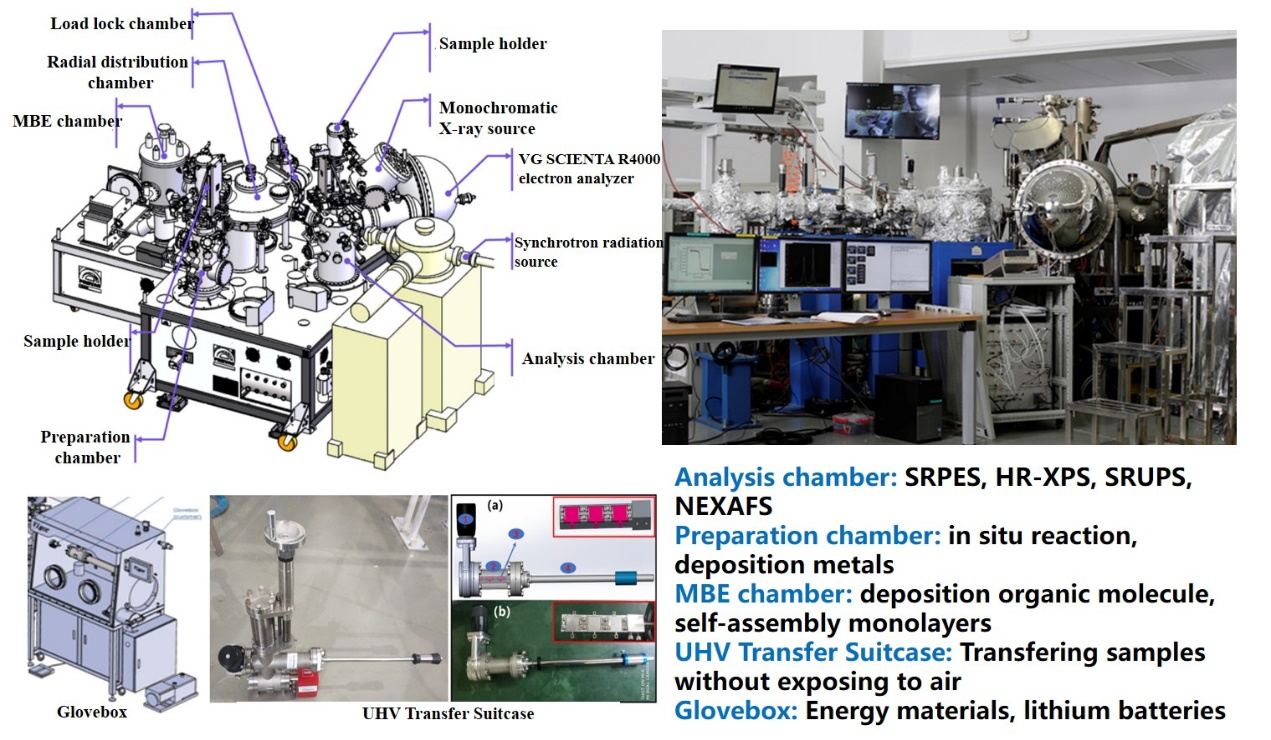
Theory of SRPES
The fundamental theory used in photoelectron spectroscopy is Einstein's law of the photoelectric effect. When X-rays, electron beams, ultraviolet light, ion beams or neutron beams with certain energy emitted by an excitation source act on the surface of a sample, they can excite electrons of different energy levels in the atoms on the sample surface, generating photoelectrons or Auger electrons, etc. These free electrons with characteristic kinetic energy carry sample surface information collected by the energy analyzer, thereby obtaining the corresponding energy distribution of the emitted photoelectrons. The relationship curve between the electron signal intensity and the electron energy is the photoelectron spectrum. Due to the superiority that conventional light sources cannot match, such as high brightness, high resolution, wide spectral bandwidth and continuously adjustable wavelength, the photoelectron spectra excited by synchrotron radiation sources are beyond the reach of those excited by conventional light sources in terms of surface sensitivity, energy resolution, as well as temporal and spatial resolution. For example, based on the relationship between the inelastic scattering mean free path (IMFP) of electrons and the variation of the kinetic energy of the emitted electrons, a light source with appropriate energy can be selected as the excitation source, so that the energy of the emitted photoelectrons falls within the minimum range of IMFP. The information obtained in this way mainly comes from the surface, which is crucial for studying the surface structure and catalytic process of the catalyst. It cannot be achieved by the photoelectron spectrum of conventional light sources, and by regulating the energy of incident photons, the chemical structure information of samples at different depths can also be obtained.
Theory of NEXAFS
NEXAFS is a type of X-ray absorption Near Edge structure (XANES), mainly used for analyzing the chemical state and local environment of elements in materials. It is an X-ray absorption spectroscopy technique used to study the electronic structure of materials. NEXAFS technology acquires the electronic structure information of materials by measuring the fine structural changes of materials near the X-ray absorption edge. The main measurement energy range is distributed in the interval from 30 eV before the absorption edge to 50 eV after the absorption edge. The mechanism of NEXAFS generation is as follows: When the core energy level electrons of an atom absorb X-rays, they do not have sufficient energy to break free from the sample's confinement but instead transition to some unfilled empty orbitals above the Fermi level and below the vacuum level. According to the molecular orbital theory, there exist bonding and antibonding orbitals in polyatomic molecules. The antibonding orbitals are above the Fermi level and are the final state orbitals of electron transitions, and these orbitals have different energy levels. Therefore, adjusting the energy of the excited photons can enable electrons to transition to these orbits under certain specific energy excitations, which is known as resonant absorption. Taking the absorbed photon energy as the X-axis and the intensity of the response signal generated after absorption as the Y-axis, it is the NEXAFS spectrum.
Surface electronic structure analysis
The Catalysis and Surface Science endstation can conduct SRPES and NEXAFS tests at the same site of the same sample. SRPES can provide the valence state and bonding conditions of the element to be tested, while NEXAFS can offer the atomic structure and coordination environment of the element to be tested. Through the combination of SRPES and NEXAFS, the electronic structure information of the material can be further obtained.
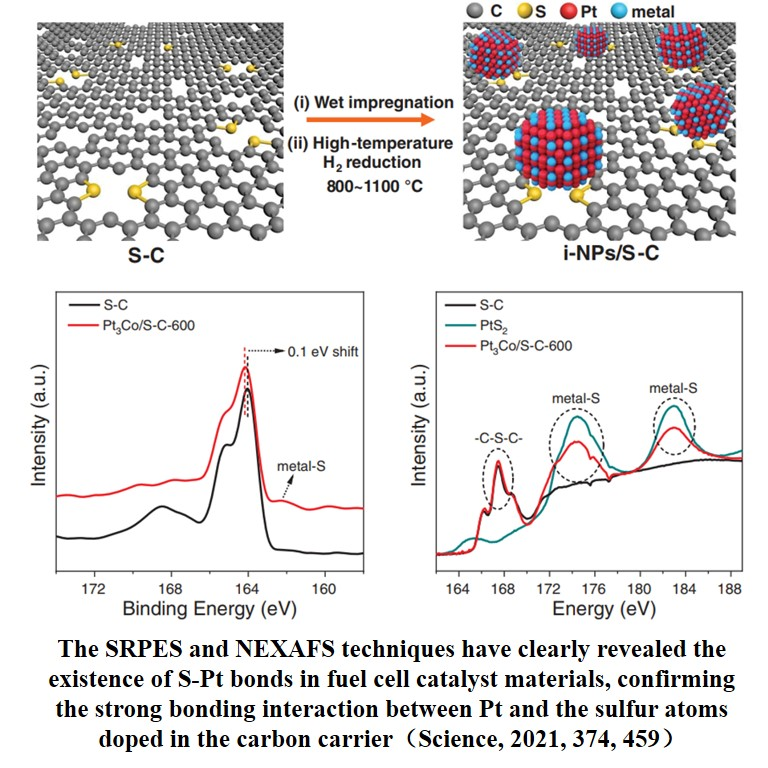
Surface reaction mechanism
The electronic structure information of surface reaction intermediates was obtained by combining SRPES with SRUPS and the reaction mechanism was derived, providing a new idea for designing catalyst systems with high selectivity and high catalytic activity.
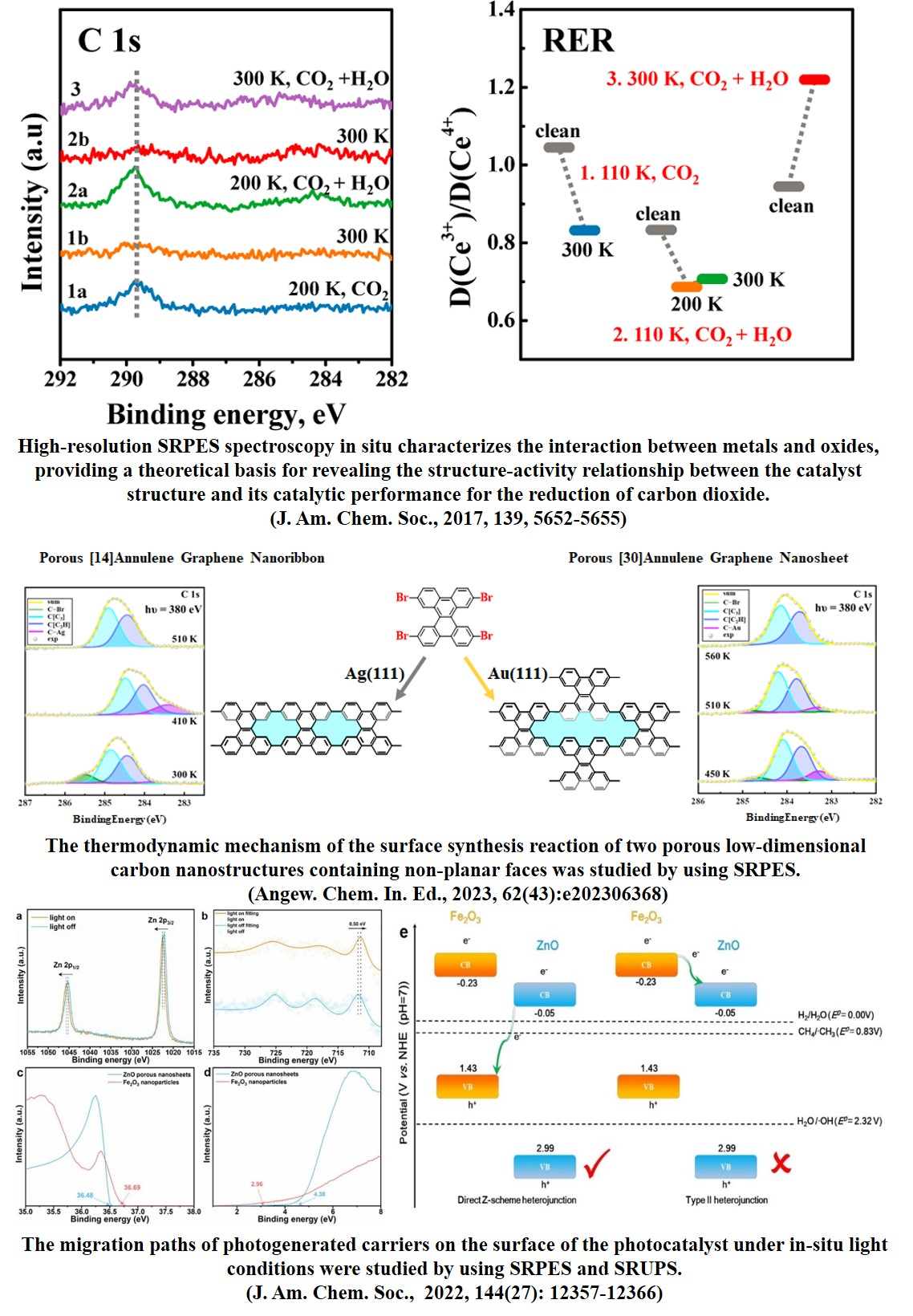
Surface and interface structure
The analysis of the electronic structure of the sample surface and interface is achieved by changing the energy of the incident photons or by altering the Angle between the sample and the analyzer.
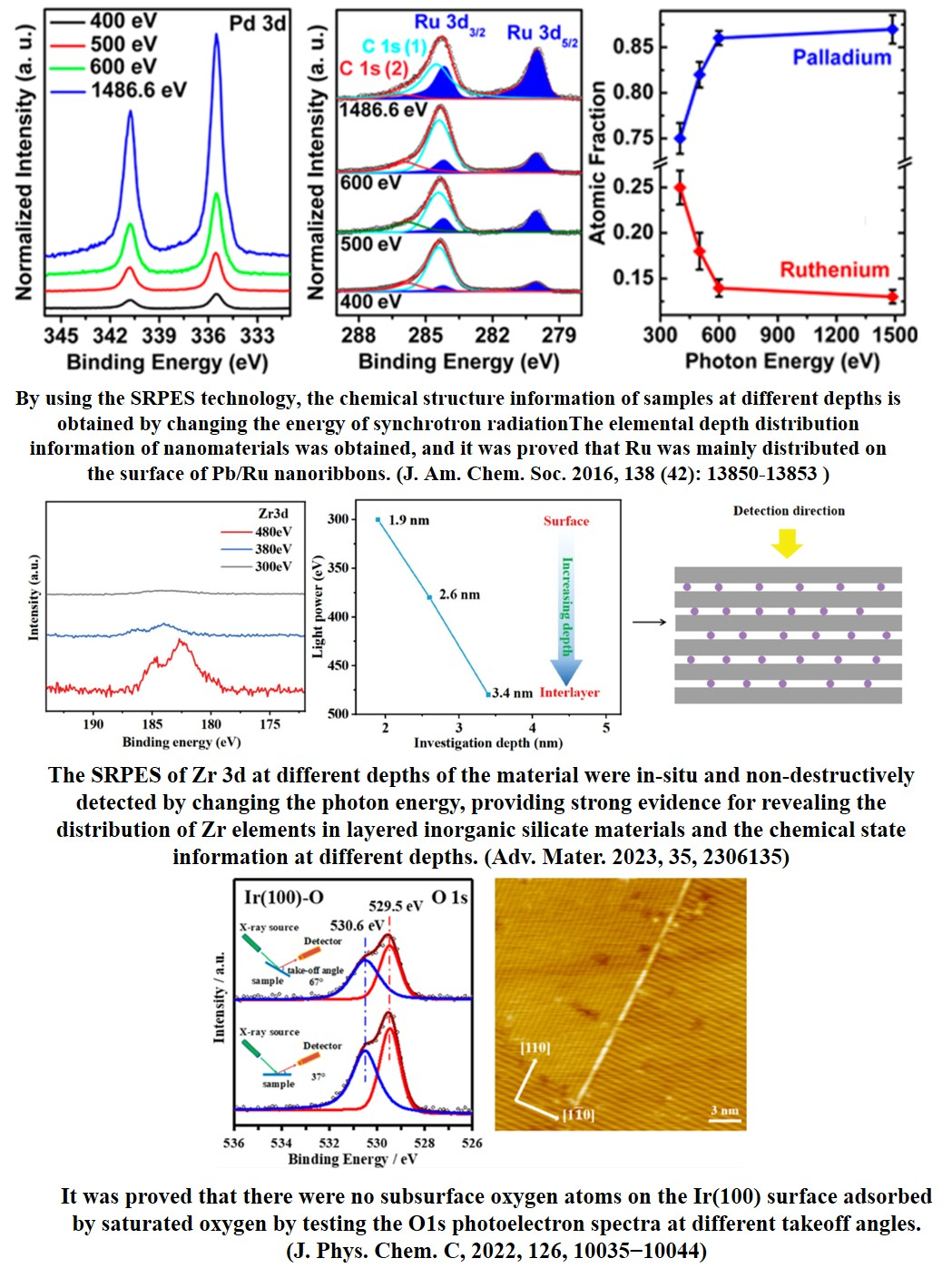
Interface properties of optoelectronic devices
Based on the powerful research platform of the Catalysis and Surface Science endstation, combined with the advantages of synchrotron radiation light, detection of the interface formation process in solar cell devices (including organic photovoltaic cells, organic-inorganic hybrid perovskite solar cells, etc.) by photoelectron spectroscopy is carried out to accurately obtain the interface properties, thereby effectively providing assistance for the design and fabrication of solar cell devices.
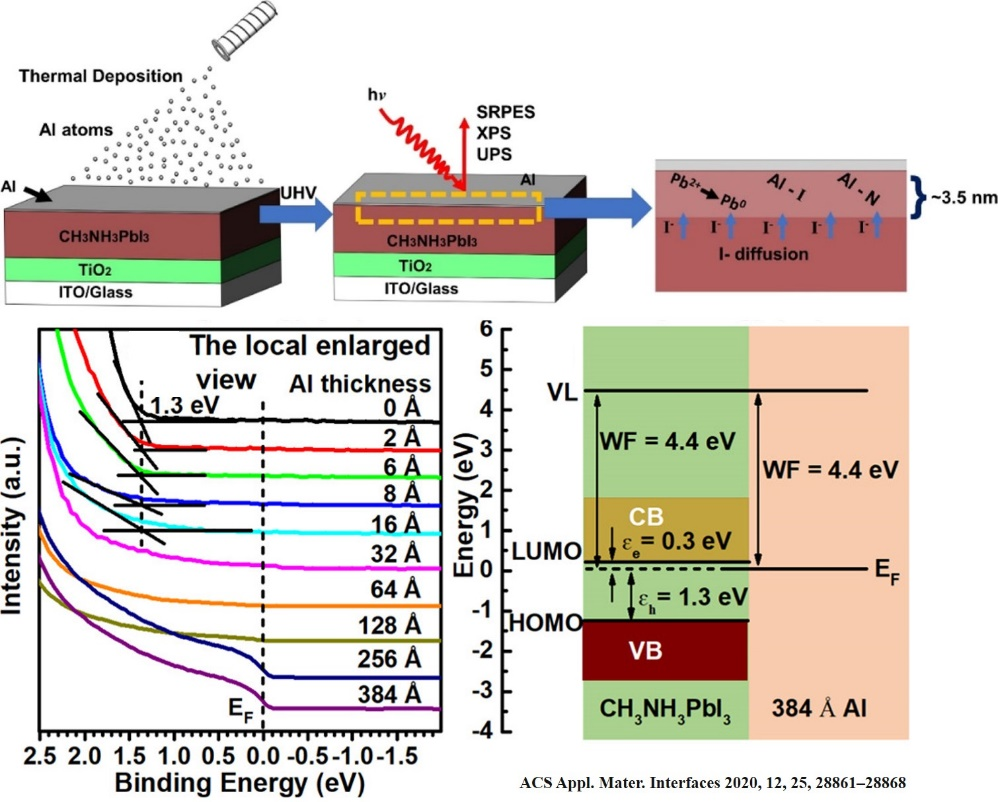
Back

